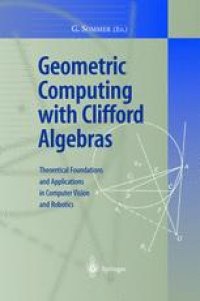
Ebook: Geometric Computing with Clifford Algebras: Theoretical Foundations and Applications in Computer Vision and Robotics
- Tags: Image Processing and Computer Vision, Computer Graphics, Artificial Intelligence (incl. Robotics), Symbolic and Algebraic Manipulation, Algebraic Geometry
- Year: 2001
- Publisher: Springer-Verlag Berlin Heidelberg
- Edition: 1
- Language: English
- pdf
Clifford algebra, then called geometric algebra, was introduced more than a cenetury ago by William K. Clifford, building on work by Grassmann and Hamilton. Clifford or geometric algebra shows strong unifying aspects and turned out in the 1960s to be a most adequate formalism for describing different geometry-related algebraic systems as specializations of one "mother algebra" in various subfields of physics and engineering. Recent work outlines that Clifford algebra provides a universal and powerfull algebraic framework for an elegant and coherent representation of various problems occuring in computer science, signal processing, neural computing, image processing, pattern recognition, computer vision, and robotics. This monograph-like anthology introduces the concepts and framework of Clifford algebra and provides computer scientists, engineers, physicists, and mathematicians with a rich source of examples of how to work with this formalism.
Clifford algebra, then called geometric algebra, was introduced more than a cenetury ago by William K. Clifford, building on work by Grassmann and Hamilton. Clifford or geometric algebra shows strong unifying aspects and turned out in the 1960s to be a most adequate formalism for describing different geometry-related algebraic systems as specializations of one "mother algebra" in various subfields of physics and engineering. Recent work outlines that Clifford algebra provides a universal and powerfull algebraic framework for an elegant and coherent representation of various problems occuring in computer science, signal processing, neural computing, image processing, pattern recognition, computer vision, and robotics. This monograph-like anthology introduces the concepts and framework of Clifford algebra and provides computer scientists, engineers, physicists, and mathematicians with a rich source of examples of how to work with this formalism.
Clifford algebra, then called geometric algebra, was introduced more than a cenetury ago by William K. Clifford, building on work by Grassmann and Hamilton. Clifford or geometric algebra shows strong unifying aspects and turned out in the 1960s to be a most adequate formalism for describing different geometry-related algebraic systems as specializations of one "mother algebra" in various subfields of physics and engineering. Recent work outlines that Clifford algebra provides a universal and powerfull algebraic framework for an elegant and coherent representation of various problems occuring in computer science, signal processing, neural computing, image processing, pattern recognition, computer vision, and robotics. This monograph-like anthology introduces the concepts and framework of Clifford algebra and provides computer scientists, engineers, physicists, and mathematicians with a rich source of examples of how to work with this formalism.
Content:
Front Matter....Pages I-XVIII
Front Matter....Pages 1-1
New Algebraic Tools for Classical Geometry....Pages 3-26
Generalized Homogeneous Coordinates for Computational Geometry....Pages 27-59
Spherical Conformal Geometry with Geometric Algebra....Pages 61-75
A Universal Model for Conformal Geometries of Euclidean, Spherical and Double-Hyperbolic Spaces....Pages 77-104
Geo-MAP Unification....Pages 105-126
Honing Geometric Algebra for Its Use in the Computer Sciences....Pages 127-152
Front Matter....Pages 153-153
Spatial-Color Clifford Algebras for Invariant Image Recognition....Pages 155-184
Non-commutative Hypercomplex Fourier Transforms of Multidimensional Signals....Pages 187-207
Commutative Hypercomplex Fourier Transforms of Multidimensional Signals....Pages 209-229
Fast Algorithms of Hypercomplex Fourier Transforms....Pages 231-254
Local Hypercomplex Signal Representations and Applications....Pages 255-289
Introduction to Neural Computation in Clifford Algebra....Pages 291-314
Clifford Algebra Multilayer Perceptrons....Pages 315-334
Front Matter....Pages 335-335
A Unified Description of Multiple View Geometry....Pages 337-369
3D-Reconstruction from Vanishing Points....Pages 371-392
Analysis and Computation of the Intrinsic Camera Parameters....Pages 393-414
Coordinate-Free Projective Geometry for Computer Vision....Pages 415-454
The Geometry and Algebra of Kinematics....Pages 455-470
Kinematics of Robot Manipulators in the Motor Algebra....Pages 471-488
Using the Algebra of Dual Quaternions for Motion Alignment....Pages 489-499
Back Matter....Pages 531-551
The Motor Extended Kalman Filter for Dynamic Rigid Motion Estimation from Line Observations....Pages 501-528
Clifford algebra, then called geometric algebra, was introduced more than a cenetury ago by William K. Clifford, building on work by Grassmann and Hamilton. Clifford or geometric algebra shows strong unifying aspects and turned out in the 1960s to be a most adequate formalism for describing different geometry-related algebraic systems as specializations of one "mother algebra" in various subfields of physics and engineering. Recent work outlines that Clifford algebra provides a universal and powerfull algebraic framework for an elegant and coherent representation of various problems occuring in computer science, signal processing, neural computing, image processing, pattern recognition, computer vision, and robotics. This monograph-like anthology introduces the concepts and framework of Clifford algebra and provides computer scientists, engineers, physicists, and mathematicians with a rich source of examples of how to work with this formalism.
Content:
Front Matter....Pages I-XVIII
Front Matter....Pages 1-1
New Algebraic Tools for Classical Geometry....Pages 3-26
Generalized Homogeneous Coordinates for Computational Geometry....Pages 27-59
Spherical Conformal Geometry with Geometric Algebra....Pages 61-75
A Universal Model for Conformal Geometries of Euclidean, Spherical and Double-Hyperbolic Spaces....Pages 77-104
Geo-MAP Unification....Pages 105-126
Honing Geometric Algebra for Its Use in the Computer Sciences....Pages 127-152
Front Matter....Pages 153-153
Spatial-Color Clifford Algebras for Invariant Image Recognition....Pages 155-184
Non-commutative Hypercomplex Fourier Transforms of Multidimensional Signals....Pages 187-207
Commutative Hypercomplex Fourier Transforms of Multidimensional Signals....Pages 209-229
Fast Algorithms of Hypercomplex Fourier Transforms....Pages 231-254
Local Hypercomplex Signal Representations and Applications....Pages 255-289
Introduction to Neural Computation in Clifford Algebra....Pages 291-314
Clifford Algebra Multilayer Perceptrons....Pages 315-334
Front Matter....Pages 335-335
A Unified Description of Multiple View Geometry....Pages 337-369
3D-Reconstruction from Vanishing Points....Pages 371-392
Analysis and Computation of the Intrinsic Camera Parameters....Pages 393-414
Coordinate-Free Projective Geometry for Computer Vision....Pages 415-454
The Geometry and Algebra of Kinematics....Pages 455-470
Kinematics of Robot Manipulators in the Motor Algebra....Pages 471-488
Using the Algebra of Dual Quaternions for Motion Alignment....Pages 489-499
Back Matter....Pages 531-551
The Motor Extended Kalman Filter for Dynamic Rigid Motion Estimation from Line Observations....Pages 501-528
....